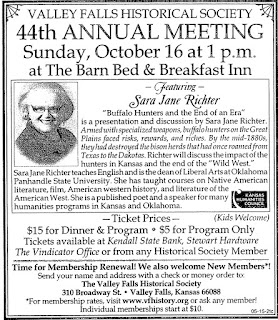- Compiled by Betty Jane Wilson, President, Valley Falls Historical Society.
"Many lives were molded for future years in one-room school buildings," wrote the late Dale Irwin of Valley Falls, in his history of Pacific School. Other writers have written that, although territorial settlers were living in the poorest of cabins on the open prairies, bleak and barren in winter, they were willing to vote themselves a tax to support a school.
In the early days the terms of school in Jefferson County might vary in length and season according to the weather. Some were held in settlers' cabins until school houses could be built. As soon as they were built, they became neighborhood centers and were used for Sunday school and preaching services, singing schools, literary and political meetings and community social gatherings.
One of the school districts organized in Territorial Days was Peters Creek District No. 21. Noah Harman, an early Grasshopper Falls settler, hauled logs with an ox team to the sawmill and the lumber back to the grounds, donated the site for the school house, paid half the bill for building, and taught the first term of school.
In his History of Pacific School, Irwin notes that, Jefferson County Superintendents' records show District No. 5 (Brush Creek) organized in 1864. Probably so named since it was located a short distance from a creek known as Brush Creek, located approximately 3 miles east of Grasshopper Falls. Unlike most rural histories, although incomplete, records start from entries in the official records of the Methodist Church of Grasshopper Falls, Kansas, by J.A. Simpson, pastor.
The entry dated April 8, 1870, states that at the Kansas Conference of the Methodist Church at Topeka, J.A. Simpson was appointed minister of the Methodist Church and in this circuit were three appointments, Grasshopper, Brush Creek, and Center School (District No. 1). Membership at Grasshopper Falls, 62, Brush Creek, 32, and Center, 20, two Sunday schools, one at Grasshopper Falls and the other at Brush Creek. Preaching was held every two weeks on the Sabbath at Brush Creek. Irwin conducted an interview with Martha Griffin ( Mrs. Geo. McCoy), born March 10, 1873, who provided the following information:
"The first school was of frame construction and was surrounded by trees. It was on land known as the Bates' farm, later owned by Charles Heller."
Ed. Note: The other sources state "Southwest corner of the Cooling farm."
Continuing with Mrs. McCoy's memories:
"I attended my first year at Brush Creek, 1879-80. The teacher was Fannie Bausley. The second school was built in 1881 and the name Pacific suggested by my Uncle Al A. Griffin, meant peaceful or tranquil and, as I remember, appropriately named on most occasions."
The school closed in 1942 and the teacher's list from 1916 to 1942 included Josephine Sampson, Pearl White, Elsie White, Grace Shughart, Clara Young, Vera Early (Mrs. Lloyd Hatfield), Mabel Page, Mabel Sampson, Hazel Barnard McClenny, Rachel Carter, Blanche Reppert, Meta Johannes, and Evelyn Agee.
Longest years taught, Hazel Barnard McClenny, 1930 to 1935, and Evelyn Agee, 1938 to 1942.
Information sources: Dale Irwin's History of Pacific and First Schools in Valley Falls by Lida K. Ferguson (Mrs. Earl E. Ferguson).
The society's museum will be open Saturday, Sept. 10, at 10 a.m. Admission is free.

